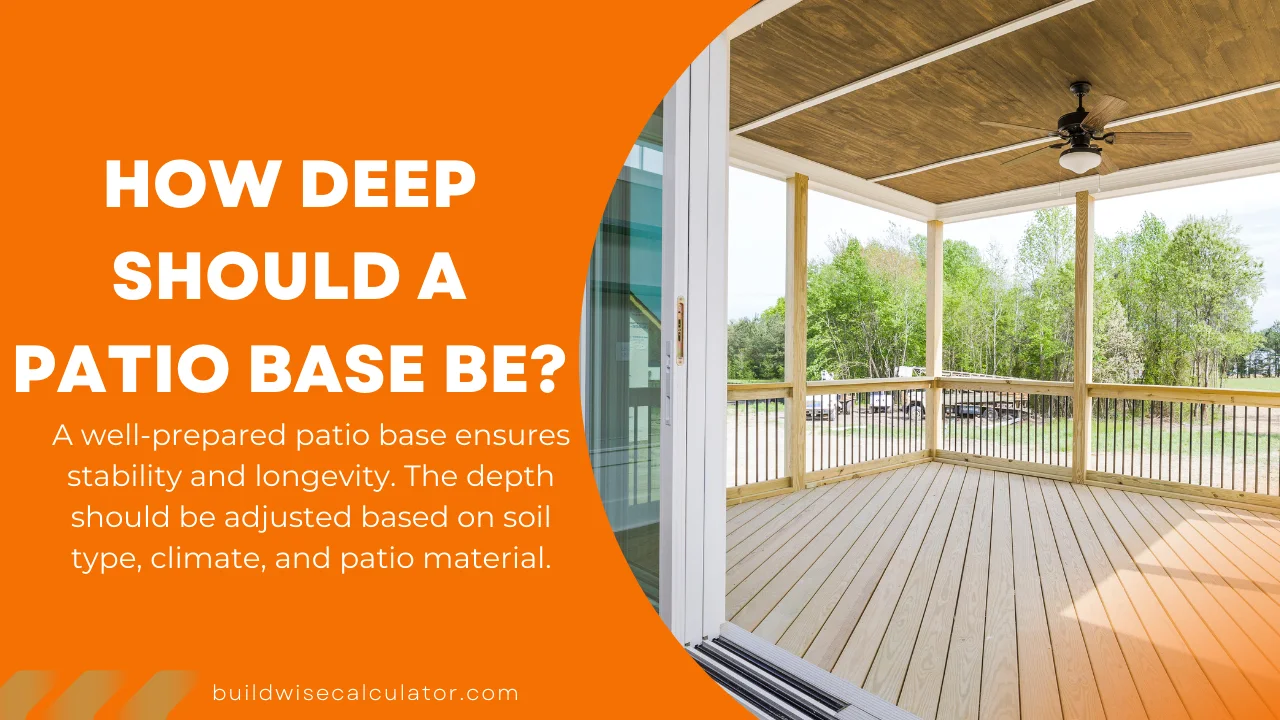How Deep Should a Patio Base Be? Expert Tips and Material Choices
Publish on: 13-Mar-2025

A solid patio starts with the right base. If the foundation isn't deep enough or the wrong materials are used, your patio may shift, crack, or become uneven over time. In this guide, we’ll cover how deep a patio base should be, factors that influence depth, and the best materials to use for a long-lasting patio.
Why Patio Base Depth Matters
The depth of your patio base is crucial for:
- Stability – Prevents shifting and sinking over time.
- Drainage – Reduces water buildup that can damage the patio surface.
- Longevity – A well-prepared base extends the lifespan of your patio.
Without the proper depth, your patio may crack or become uneven, leading to expensive repairs.
Recommended Depth for a Patio Base
General Guidelines
The ideal base depth depends on the patio material and soil conditions, but a 4 to 8-inch base is common. Here’s a simple breakdown:
- Gravel and sand base (pavers or bricks) – 4 to 6 inches
- Concrete base – 6 to 8 inches
- Clay or soft soil areas – 8 to 12 inches (to prevent sinking)
Factors That Affect Base Depth
-
Soil Type
- Firm soil (rocky or compacted) – Requires less depth.
- Soft soil (clay or loose sand) – Needs a deeper base for stability.
-
Climate and Frost Depth
- In cold climates, the base should be deep enough to prevent frost heave (typically 8 to 12 inches).
- Warmer regions with stable soil may only require 4 to 6 inches.
-
Weight of the Patio Surface
- Light materials (pavers, bricks) – Need less depth.
- Heavy materials (concrete, natural stone) – Require a deeper, more compacted base.
-
Usage and Load
- Walking areas – 4 to 6 inches.
- Driveway or heavy loads – 8 to 12 inches.
Best Materials for a Strong Patio Base
1. Crushed Stone or Gravel
- Ideal for: Paver patios, brick patios.
- Depth: 4 to 6 inches.
- Benefits: Good drainage, prevents shifting.
- Tip: Compact each layer properly for a firm foundation.
2. Sand
- Ideal for: Paver patios as a leveling layer.
- Depth: 1 inch on top of gravel.
- Benefits: Provides a smooth surface for pavers.
- Tip: Use polymeric sand to lock pavers in place.
3. Concrete
- Ideal for: Concrete slab patios.
- Depth: 6 to 8 inches.
- Benefits: Strong and long-lasting.
- Tip: Use a gravel base underneath for extra strength.
4. Limestone Screening
- Ideal for: A compacted base under pavers.
- Depth: 4 to 6 inches.
- Benefits: Helps with stability and prevents shifting.
- Tip: Compact well to avoid future sinking.
Step-by-Step Guide to Preparing a Patio Base
-
Mark the Patio Area
- Use stakes and string to outline the patio.
-
Excavate the Base Depth
- Dig to the required depth based on soil and patio type.
-
Add and Compact Gravel
- Spread crushed stone and compact it in layers.
-
Add Sand or Concrete Base
- Apply sand for pavers or pour concrete for a solid slab.
-
Level and Install Patio Material
- Ensure a flat surface before placing pavers, bricks, or pouring concrete.
Common Mistakes to Avoid
- Skipping compacting – Leads to uneven surfaces and sinking.
- Not digging deep enough – Causes shifting and cracks over time.
- Poor drainage planning – Can result in water pooling and damage.
- Using the wrong materials – Choose a base that suits your patio type.
To make your patio project even easier, use our Patio Base Calculator – Calculate the Volume of Material and Cost. This tool helps you determine the exact amount of gravel, sand, or concrete needed for your base, saving you time and money.
Conclusion
A well-prepared patio base ensures stability and longevity. The depth should be adjusted based on soil type, climate, and patio material. Using the right base materials—such as crushed stone, sand, or concrete—helps prevent shifting and cracking. Taking the time to build a proper foundation will save you money and effort in the long run.
Recent Posts
How Much Rebar Do I Need? – A Complete Guide
How Much Epoxy Do You Need for Your Floor?
How to Calculate Yards of Concrete: A Simple Guide for Your Next Project
Difference Between Cement and Concrete: What You Need to Know
How to Calculate Tile for a Shower: A Beginner’s Step-by-Step Guide
Roof Truss: Picking the Right Thickness for Your Project
Concrete Slab Construction: Materials, Process & Thickness Rules
How to Calculate Square Feet of a Wall: A Beginner’s Step-by-Step Guide
What is Crown Molding? Its Pros, Cons, and Uses
What is MDF? A Complete Guide to Medium-Density Fiberboard
What is Concrete? History, Types, Costs, and Tips for Working with It
What is Asphalt, How is it Made, and How Much Does it Cost?
Drywall: A Complete Guide to Installation, Repair, and Finishing
Floor Wax Guide: Best Practices for Wood, Tile, and Hardwood Surfaces
Tar and Gravel Roofs: A Durable Roofing Solution for Modern Homes
What Masonry Sand Is and Its Uses
Building and Installing Post and Rail Fences
Best Plywood Types for Roofing: Strength, Durability, and Protection
Slope: Why It Matters and How to Define It
Roof Panels: Types, Installation, Costs, and Maintenance
Electric Fences: Installation, Costs, Testing, and How They Work
How to Calculate Acreage of an Irregular Lot?
Deck Posts: Types, Materials, Pros & Cons, and Spacing
Types of Stone Wall: A Complete Guide
Mild Steel vs Carbon Steel | What is the differance?
How Deep Should a Fence Post Be?
5052 vs. 6061 Aluminum: Key Differences and Best Uses
Carpet Area vs Built-Up Area: What’s the Difference and How to Calculate?